Diving the Nuclear Ghost Fleet at Bikini Atoll
by Lloyd Borrett — March 2013
Bikini Atoll is without a doubt, the top wreck diving destination on the planet! Soon after I started diving back in 2006 I met Peter Fear, The Scuba Doctor (www.scubadoctor.com.au). I started to hear stories from Peter, plus some of the others who had been with Peter on a dive expedition to Bikini Atoll in 2005, about how great the place was. Some of the guys on that trip stopped diving for more than two years afterwards saying, "What's the point, nothing can top Bikini Atoll!"
By the time Peter Fear returned from his second expedition to Bikini Atoll in 2007 I was salivating at the concept of diving the USS Saratoga (CV-3), an aircraft carrier and one of the world's largest "dive-able" wrecks. So I booked to go on the 2009 expedition and started to do the training to get the skills and certifications I'd need.
Back then around 250 or so divers a year got to go to this remote location in the Marshall Islands. The Bikini people had setup a land-based diving operation and you could fly in to Bikini Atoll via Majuro Atoll. Back then an expedition spot cost more than A$12,000 plus expenses for a 2 week trip per diver. Yet it was still a destination every serious wreck diver dreamed of getting to.
Late in 2007, the land-based operators cancelled diving at Bikini Atoll because they couldn't rely on the airline to get people in and out. Disaster! How was I ever going to fulfil my dream of diving on the sunken ghost warships of the nuclear fleet? Without a major lottery win, or the ability to hook up with someone going there by boat as Paul Allen, the co-founder of Microsoft, did on his luxury 126 metre mega-yacht 'Octopus', it looked like I would never get to dive at Bikini Atoll.

HMS Hermes (95).
Photo: UK MilitaryThen one Wednesday afternoon in October 2010, just a few weeks after returning from an expedition diving the British HMS Hermes (95) aircraft carrier sunk by the Japanese in WWII off Batticolola, Sri Lanka, I got a call from Peter Fear saying, "There's a boat leaving to go to Bikini Atoll on Sunday and there's a spot on it if you want it?" About 30 minutes later my boss came into my office and asked why I was looking so depressed. I told him about the offer, and he said, "Go!" I then explained my work commitments for the next three weeks, and he said, "Don't go!"
So Peter Fear was off on his third trip to Bikini Atoll. This time it was a trial liveaboard expedition on the Indies Trader Marine Adventures vessel Indies Trader. Martin Daley, the owner operator, had invited Peter Fear, plus Pete Mesley from New Zealand, along to offer their expertise on setting up the live aboard dive operation.
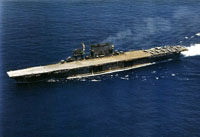
USS Saratoga (CV-3).
Photo: USA MilitaryWithin a few short weeks of diving on HMS Hermes (95), the world's first aircraft carrier, Peter was diving on the USS Saratoga again. Lucky bugger! There are only three aircraft carriers in the world you can dive on, and he'd got to dive two of them within a month of each other. (The third is the USS Oriskany (CV-34) sunk as an artificial reef, now popularly known as the "Great Carrier Reef", off Florida, USA.)
The trial liveaboard diving expedition to Bikini Atoll was a great success and Indies Trader Marine Adventures obtained the only license to dive Bikini and scheduled dive expeditions for 2011. I immediately booked to go on one with Peter Fear, but had to cancel because of work. I then booked to go on The Scuba Doctor's expedition in February 2012, and again had to cancel because of work. But, in October 2012, I finally made it to Bikini Atoll!
The Journey
Bikini Atoll is a remote place, situated in a lonely part of the world, just north of the equator in the Pacific Ocean halfway between Australia and Hawaii. It's one of the 29 atolls and five islands that compose the Marshall Islands, and part of the geographic area referred to as Micronesia.
I flew from my home in Melbourne to Cairns with Peter Fear (on his sixth trip to Bikini Atoll) on a Thursday morning and we met up with two other Australian divers there — Fiona Edwards and Steve Crosling. Then just after midnight on the Friday, we continued onto Guam where we met up with three other divers — Michael Cooper, Oliver Bourquin and Emmanuel Raze — who'd flown in from Europe. But there was a problem.
We were being told by United Airlines that a severe storm was beating up Kwajalein Atoll, our departure point for the Indies Trader liveaboard vessel MV Windward, and we might not be able to land there. We got on the next island hopper flight anyway, with the hope that we'd make it to Kwajalein.
First stop Chuuk Lagoon and we waited to get an update from the airline captain. Not looking good. Then onto Pohnpei, where we were told the truth. There wasn't a storm. The USA were conducting missile testing at Kwajalein Atoll and the airspace was closed! So we continued on to Kosrae and then bypassed Kwajalein and flew into Majuro. On Saturday morning we joined up with five other divers — Bill Jakab, John Lundberg, Stephen Pahl, Warren Wisnewski and James Wisnewski — who were coming from the USA via Hawaii. We all took off for Kwajalein.

Missile test facilities at Kwajalein Atoll.
Photo: Lloyd BorrettFlying into an American Ballistic Missile testing base that is at 'Code Alpha', where the Americans just don't want visitors, was certainly an experience. Those guys are paranoid! By midday we cleared customs and were escorted to the ferry terminal by US military officials, where we were greeted by Edward Maddison, the Bikinian dive master for the expedition. Eventually, come late afternoon, we boarded an army ferry boat and headed for Ebeye Island, a short distance away.
The MV Windward liveaboard was there to meet us. Chris Abrahams, the Aussie boat captain, and Peter Fear took us through the safety briefing and showed us around. This is a working boat, not a luxury liveaboard, and we'd be travelling to a very remote location and doing some deep (50–54 metre) technical diving and long run times. So we paid attention.
Each of the twelve of us chose a bunk bed in the large, one room, lower accommodation hold and then started to unpack and setup our kit on the dive deck. The shared accommodation is really not a problem and quite comfortable. But if you're looking for your own cabin with ensuite, this is not the boat for you!
Operation Crossroads
The Second World War ended shortly after the Americans dropped two atomic bombs in Japan, the first one 'Liitle Boy' on Hiroshima on 6 August 1945, and the second 'Fat Man' on Nagasaki three days later. These were the second and third atomic bombs, in history, detonated on earth, the first being the Trinity nuclear test on 16 July 1945. But as they were used on civilian targets, nothing was known about atomic warfare and the effects of atomic blasts on military targets.
Amid great publicity, the USA launched the spectacular and expensive 'Operation Crossroads' to determine the effect of atomic bombs on American warships. Yes, as ridiculous as it seems to us today, they wanted to know if atomic bombs would sink warships at sea. Bikini Atoll, because of its remote location away from regular air and sea routes, was chosen as the new nuclear proving ground.

Bikini people leaving Bikini Atoll in 1946.
Photo: US MilitaryWhile the 167 Bikinians were getting ready to be relocated from their tropical paradise, "for the good of mankind", some 242 naval ships, 156 aircraft, 25,000 radiation recording devices, plus more than 5,600 experimental rats, mice, goats, pigs and guinea pigs soon began to arrive for the test. Over 42 thousand military and civilian personnel were involved in the operation. Eighteen tons of cinematography equipment and more than half of the world's supply of motion picture film were on hand to record the atomic bomb detonations. In all, cameras at Bikini would take 50,000 still pictures and 457 km of motion picture film.
Around the same time French fashion designer Louis Reard was looking for a name for his new, controversial, tiny swimsuit design and the "Bikini" was launched. It was proclaimed that this swimsuit was going to have the same effect on the male libido as the nuclear bombs had on Bikini Atoll!
Even though there was considerable interest by scientists excited about assessing the full effects of atomic energy in the field, Operation Crossroads was still for the sole benefit of the military. Their main goal was to make stronger, deadlier nuclear weapons, and see how a navy could withstand a nuclear attack. But it was also about flexing their muscles to the rest of the world, so they invited military and political representatives from all over the world, including the USSR.
Ninety-five ships — the equivalent of the sixth-largest navy in the world at the time — were prepared as the target fleet for the atomic blasts: 4 US battle ships, 2 aircraft carriers, 2 cruisers, 11 destroyers, 8 submarines, numerous amphibious and auxiliary vessels, plus three surrendered German and Japanese warships. Most were fully loaded with weapons and fuel ready for action. Some had special scientific experiments placed on them.

Operation Crossroads target fleet in Bikini Lagoon. Photo: US Military
To see what the atom bombs might do to living things, the experimental animals were put aboard to replace the crew. Servicemen sheared a number of them and put suntan lotion on their bare skin to see if that would somehow mitigate the effects of the radiation.
Operation Crossroads consisted of two nuclear detonations, each with a yield equivalent to 23 kilotons of TNT.
The Test Able atomic bomb was dropped from the B-29 Superfortress "Dave's Dream" and detonated at an altitude of 158 metres at 9 a.m. on 1 July 1946. This airburst was meant to duplicate the conditions of the Hiroshima bomb drop, this time, over water. It was something of a dud test, because the bomb missed the target ship — USS Nevada (BB-36) battleship — by 650 metres. Oops!
The ships sunk by this blast included: the USS Gilliam and USS Carlisle attack transports which sank immediately; the USS Anderson and USS Lamson destroyers which sank within hours of the blast; and the Japanese IJN Sakawa light cruiser which sank the following day. A further 14 ships sustained serious damage.
The Test Baker atomic bomb was detonated 27 metres underwater beneath the landing craft LSM-60 on 25 July 1946. The ships sunk by this blast included: LSM-60 amphibious (no identifiable part of LSM-60 was ever found and it was presumed vaporised by the nuclear fireball), USS Arkansas battleship, USS Pilotfish submarine, USS Saratoga aircraft carrier, YO-160 yard oiler, HIJMS Nagato battleship, USS Skipjack submarine, USS Apogon submarine, and ARDC-13 dry-dock.

Test Baker underwater atomic bomb blast at Bikini Atoll. Photo: US Military
The radioactive contamination of the lagoon and target ships from the Test Baker underwater blast caused far greater problems than were expected. The German heavy cruiser Prinz Eugen, sank in December 1946 at Kwajalein Atoll, five months after the atomic tests, because high levels of radioactivity prevented repairs to a leak in the hull. Only nine surviving Test Baker target ships were eventually decontaminated and sold for scrap. The rest were sunk at sea, mostly near Kwajalein Atoll, after decontamination efforts failed.
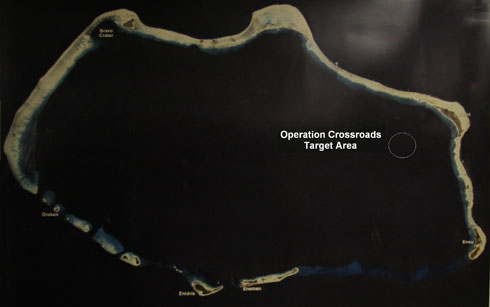
Aerial map of Bikini Atoll. Photo: US Military
Thus Bikini Lagoon became the final resting place for some of the most historically significant warships in naval history. The dangers of the radioactivity and limited services in the area led to divers staying away from this most remarkable scuba diving site for many years. However, from the dust and detritus of the nuclear weapon tests, the lagoon at Bikini Atoll has emerged as the world's greatest wreck diving site.
Note: During 1954, 1956, and 1958, twenty-one more nuclear bombs were detonated at Bikini Atoll, yielding a total of 75 megatons, equivalent to more than three thousand Test Baker bombs. The first after Operation Crossroads was the dirtiest: the 15 megaton Castle Bravo shot of Operation Castle on 1 March 1954, the largest-ever US test. The blast was nearly three times greater than its creators expected. It vaporised three islands in the atoll. Fallout from Castle Bravo test caused radiation injury to the islanders living on Rongelap Atoll at the time. Of all of the nuclear testing conducted by the USA, 80% of the radioactive fallout resulted from test explosions at Bikini Atoll.
Diving the Prinz Eugen
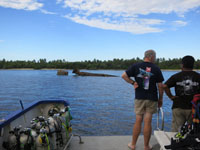
Prinz Eugen heavy cruiser at Kwajalein Atoll.
Photo: Lloyd BorrettOn Sunday morning, MV Windward motored over to the site of the German heavy cruiser Prinz Eugen. This warship saw extensive action during World War II, and attempted a breakout into the Atlantic Ocean with the battleship Bismarck in May 1941. The two ships engaged the British battle cruiser Hood and battleship Prince of Wales in the Battle of Denmark Strait, during which Hood was destroyed and Prince of Wales was severely damaged.
After WWII, the Prinz Eugen was awarded as a war prize to the United States and taken to Bikini Atoll in 1946 to join the target fleet for Operation Crossroads. She survived the two atomic bomb blasts and was towed to Kwajalein Atoll, where a small leak went unrepaired because the radiation levels were too dangerous.
On 22 December 1946, Prinz Eugen capsized and sank within a few hundred metres of a nearby island. She now sits upside down with one of her massive stern propellers protruding out of the sea and her bow at around 38 metres.

Peter Fear at the bow of the Prinz Eugen.
Photo: Luke BaadeThe dive expedition split up into four groups: the four Aussies, the two rebreather guys, and two groups with dive guides. We dropped down amidships and made our way to the bow were we found a huge white tipped shark resting under cover. Then we made our way to the stern checking out plenty nooks and crannies along the way. With a length of 208 metres, a beam of 22 metres and displacement of 16,970 tons — this is a big boat!
For the afternoon dive, Peter Fear and I split off from the others and penetrated the Prinz Eugen. We made our way to a companion way between two decks where Peter continued on to explore an area he hadn't previously been to. (I wasn't able to get through the opening!) After about 10 minutes he returned and we continued to explore the level we were on.
There can't be a better way to do checkout dives to start a dive expedition than this!
Onwards to Bikini Atoll

Are we there yet?
Photo: Lloyd BorrettWith the divers back aboard from diving the Prinz Eugen, everything was stowed securely and MV Windward started over 28 hours of steaming to cover the 450 km (240 nautical miles) to Bikini Atoll.
On the way we sailed past Rongelap Atoll, which is not far from Rongerik Atoll where the Americans relocated the entire population of 167 Bikinians in March 1946, in preparation for Operation Crossroads. They were given a few weeks' worth of food and cheerful assurances that they could return to their lands as soon as the tests were over.
Rongerik Atoll was originally uninhabited because the Bikinians held a deep-rooted traditional belief that the atoll was inhabited by evil spirits. It was also considered to be too small to live on (it is one sixth the size of Bikini Atoll) and didn't have enough food and water to sustain life. Well, they were right!
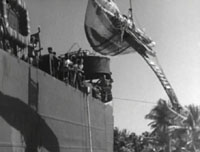
Bikini islander sailing canoe being relocated.
Photo: US MilitaryIn July 1946, medical officers from the USA visited the islands. They were shocked to find that the Bikini people were critically malnourished and literally starving to death. Immediate preparations were made to transfer them to Ujelang Atoll in the western Marshall Islands.
But then the Americans chose to establish another nuclear testing ground at Enewetak Atoll, just 200 km north east of Ujelang Atoll. Even after all the buildings were erected for the Bikinians to move into on Ujelang Atoll, it was decided that the Enewetak people would be moved to Ujelang Atoll instead.
It took two years of suffering on Rongerik Atoll until the Bikinians were finally moved to Kwajalein Atoll in March 1948. They camped miserably on a small strip of grass beside the airstrip until the USA finally found an island for them to live on.
In November 1948 the then 184 Bikinians were relocated to Kili Island. But this was a disaster, too, because little food could be grown on Kili and it was a single small island, without a lagoon. Kili Island was pounded by the three to six metres waves of the Pacific crashing against its rugged shores most of the year. This made it difficult for the people to get out to sea and receive provisions from outside. Compare this to the Bikinians homeland of 23 islands which form a calm lagoon providing them with the opportunity to fish and sail their canoes all year round. They began to refer to Kili as a "prison" island.
Today, there are about 5,000 Bikinians. Some remain on Kili Island, but most are on Ejit Island of Majuro Atoll, and there are others scattered throughout the Marshal Islands and the world. Their traditional way of life has nearly vanished. They gather food in a supermarket, not on tropical islands and from a lagoon. While some still wait the clean-up of Bikini Atoll to begin in earnest so that they can go home, sadly most have never been to Bikini. For them it's a myth.
Island Paradise?
We arrived at the anchorage site off Bikini Island late Monday afternoon. Stuff the shark curfew — be out of the water between their 1700 hrs to 0800 hrs feeding time — I jumped in to cool off from the tropical heat.
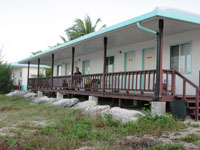
Land-based diver accommodation.
Photo: Lloyd BorrettAfter dinner on MV Windward, the four Aussies transferred onto Bikini Island where we got to stay each night in a four room accommodation block with running water, toilets, showers and air-conditioning. It was created by the Bikini people for the once successful, but now defunct, land-based dive operation that was to be an economic saviour for the Bikini people.
Edward Maddison, our Bikini dive master, showed us around the almost deserted ghost town with great pride. Typically there are only four to six people living at Bikini Atoll for six months at a time, as a skeletal caretaker staff to look after the remaining facilities. There is a poignant sign above the entrance to the machine shop that reads, "WE CAN FIX EVERYTHING EXCEPT BROKEN HEART."
It was sad to see the accommodation blocks, large kitchen and dining room, dive shop, dive briefing room and theatre on the island all siting there unused and slowly deteriorating since the land-based diving operation closed in 2008.

Don't eat the coconuts at Bikini Atoll!
Photo: Lloyd BorrettThe trees in the coconut plantations have mounds of dropped coconuts at their bases. Not to be eaten. You could stare at this tropical scene for as long as you want, but you won't see the hidden danger. The soil, while not dangerous to touch, still contains the radioactive isotope Caesium-137. The danger is that the plant life, as well as any animal life that feeds on the plants, takes in the Caesium-137 and concentrates it. So you can only eat food transported in, or caught in the sea. The fresh water on the island is manmade and safe to drink.
Sitting on the porch each morning, watching the sun come up at around 5:30 am over the staggering beauty of the immaculate, deserted white-sand beach and tranquil lagoon at Bikini Atoll, was like being in heaven on earth. The only sounds I could hear came from the seabirds wheeling above me and the lap-lap of waves on the sand. I have not seen a nicer beach anywhere in the world. There are no flies or mosquitoes to pester you on Bikini.

Bikini Island beach. Photo: Pete Mesley
And yet, we were there to see the vestiges from an atomic hell that lie deep below the surface of Bikini Lagoon.
Old 'Sara'
On Tuesday morning we transferred back onto MV Windward, had breakfast and then listened to a comprehensive history lesson and dive briefing by Brian Kirk, another dive master, and Peter Fear as we headed out to moor on the site of the USS Saratoga (CV-3) aircraft carrier. She is a steel-hulled vessel with a waterline length of 253 metres, a flight deck length of 270 metres, a beam of 33 metres, and officially weighing 37,000 standard tons. Designed to carry 78 aircraft of various types, including 36 bombers, she is BIGGER than the SS President Coolidge and the Titanic!
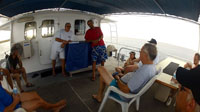
History lesson and dive briefing.
Photo: Lloyd BorrettIn February 1945, Saratoga carried night fighters during the Iwo Jima invasion and raids on the Japanese home islands. After the war, in 1945 she transported more than 29,000 servicemen back home to the states, and in 1946 was brought in for target duty at Bikini Atoll.
'Sara' survived the Test Able atomic blast with only minor damage, notably the burning of the teak on her flight deck. Saratoga was severely damaged by the Test Baker underwater atomic blast which was detonated just 370 metres from the carrier, and she sank sometime after. The best of the three "dive-able" aircraft carriers in the world, she lies upright in 50 metres of water. The superstructure is at 18 metres, flight deck at 28 metres, and the airplane hangars at 39 metres.
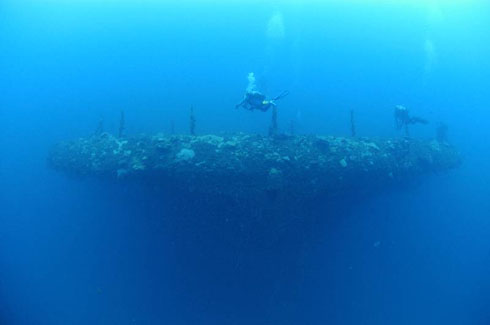
Bow of USS Saratoga. Photo: Pete Mesley
We followed the mooring line down to the flight deck near the bow and then made our way to the bow. Judging then commenced for the best dive from the bow into the vastness beyond. The sight of the upright bow of the huge warship was simply magnificent. After taking it in for a few minutes, we headed over to the starboard side and then made our way back to the tower. We checked out a brass diver's helmet along the way.
We then explored the control tower, penetrating inside to the bridge where the normal portholes were lined up against the front wall having been replaced with blast portholes with small slits, presumably used when the ship was in battle or under attack. Swimming along the flight deck as we headed back to the bow, I couldn't resist the temptation to mimic a bomber plane taking off. You could really feel the expanse of this massive ship. And yet, we'd barely covered the forward half of it on this first dive.

Helldiver plane cockpit on the Saratoga.
Photo: Pete MesleyOn our second dive that afternoon we returned to the USS Saratoga. This time we made our way to the forward elevator shaft and ventured down to see a fully intact Curtiss "Helldiver", canopy open, wings in the stowed position with live bombs in the bomb bay just a little forward of the plane. This is what it was all about!
As this wreck offers the shallowest dives in Bikini Lagoon, we would often dive on her in the afternoon as the second dive of the day. There is so much to explore that you could keep diving on 'Sara' for years and still keep finding something new. Edward Maddison started diving the nuclear ghost fleet back in the 1980s and has done more dives on 'Sara' than anyone, yet still looks forward to every dive.

Helldiver plane near USS Saratoga bow.
Photo: Pete MesleyOn a later dive we headed off the starboard side of the ship towards two more Helldivers lying on the sand. These had been secured on the deck during the atomic blast but were torn off their chains and came to rest some 40 metres away from the wreck.
The interior of the Saratoga is vast, to say the very least. Permanent lines have been laid in some areas. With 7 decks of passageways, rooms, storerooms, accommodation, galleys etc. you could spend the rest of your diving career on this warship and never grow tired of diving her!
One of the dives that totally blew my mind was when three of us, led by Peter Fear, penetrated into the dive locker and beyond. We went past the storage shelves, into a large room and then through a doorway into the dive locker where we saw two standard dress diving helmets sitting alongside each other. On coming out of the dive locker, we headed down a passageway with rooms off to either side. One was some form of dining area or kitchen, with plates stacked up high in a corner. Another had Coke bottles strewn about and I resisted the temptation to souvenir one.

Diver's helmets inside USS Saratoga.
Photo: Lloyd BorrettWe headed back outside and then went to another level into a machine shop located at the bottom of the port side of the main elevator. Lathes, drill presses, grinding pedestals, workbenches and all the other paraphernalia of a well-equipped workshop all still in situ. Everything was covered in the finest red rusty silt, possibly still radioactive if you dug deep enough into it!
This wreck is just so impressive. Countless planes, bombs, artefacts, plates, bowls, jugs etc. lay untouched since 1946. On our last dive at Bikini Atoll, three of us decided to go bow to stern and back on the Saratoga and truly take in the vast expanse of this magnificent aircraft carrier. Old 'Sara' is quite simply the greatest wreck dive in the world!
It's a battleship!
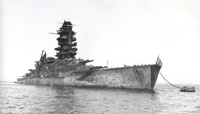
HIJMS Nagato at Bikini Atoll.
Photo: MilitaryOn the Wednesday morning I was really excited as we headed out to dive the Japanese battleship HIJMS Nagato. She was launched in 1919 and as the jewel of the Imperial Japanese Navy, was Admiral Isoroku Yamamoto's floating fortress flagship during Japan's World War II attack on Pearl Harbor. The steel hulled vessel is 221 metres long, 34 metres wide, weighed 32,720 standard tons and was capable of doing 27 knots.
She was the first battleship in the world to mount 16-inch (actually 410 mm) guns on her deck. Like me, some of you might have seen the huge shells for these guns on one of the sunken Japanese supply ships at Chuuk Lagoon.
Nagato survived the Test Able air blast, but eventually capsized and sank five days after the Test Baker underwater blast. She is upside down in 55 metres of water and is an incredible dive.
We did a live boat drop from MV Windward and headed down to the keel of the Nagato, and continued down the port side of the hull until the bridge came into view. It used to tower above the surface of the ocean, some 30 metres high, but the bridge now sits perfectly placed along the sand to one side of the ship.
We came to the exact spot where Admiral Isoroku Yamamoto gave the order "Climb Mount Niitaka" to start the Japanese attack on Pearl Harbour — a very humbling experience.
I have vivid memories journeying along the port side of the ship and under the hull in the darkness seeing two imposing 16-inch guns coated in whispery lavender rope coral. Your body is simply dwarfed by the massive gun barrels. Then at the Nagato's stern, her four colossal screws and twin rudders appear like an underwater Stonehenge. It was a truly magnificent sight.

An underwater Stonehenge on the HIJMS Nagato. Photo: Lloyd Borrett
Standard procedure for all dives was to return to the buoy line to which the support boat would be tied. It would deploy a line with a drop cylinder of EAN50 at 15 metres and another with EAN95 at 6 metres, plus a trapeze with bars at 9, 6 and 3 metres. MV Windward was live, retrieving surfacing divers after a radio call from the support boat. For dives on the Saratoga, MV Windward would tie-up to a substantial bow mooring line and deploy the trapeze and drop line.
USS Arkansas (BB-33) battleship

Diving the USS Arkansas battleship.
Photo: Bill JakobA few days later we also dived on the USS Arkansas (BB-33) battleship. Noted for the size of its main battery of twelve 12-inch guns in six twin gun turrets and 12-inch thick armour, this US battleship lies bottom side up and listing to starboard in 54 metres of water. The riveted steel vessel is 171 metres long and weighed 23,066 standard tons.
USS Arkansas served in World War I, and during World War II she escorted convoys in the Atlantic and bombarded shore targets during the invasions of Normandy in Europe, and Iwo Jima and Okinawa in the Pacific. She survived the Test Able air atomic blast, but was sunk by the Test Baker underwater atomic blast.
The first thing you notice as you drop down to the bottom of the USS Arkansas's hull (at the top!) is the terrible damage inflicted on her by the Test Baker blast. Her hull is crushed like a concertina, huge waves of buckled hull plates folded in on the more rigid structure of the girders within. There is a huge gash where the nuclear blast pierced three layers of 12-inch armour. All testaments to the mind-boggling forces unleashed by the atomic bombs!
The sunken nuclear ghost fleet
Over our eight days at Bikini Atoll we settled into expedition life and proceeded to dive on most of the sunken warships to be seen there.
USS Lamson (DD-367) destroyer

Peter Fear with a USS Lamson torpedo.
Photo: Pete MesleyOne outstanding wreck that we explored was the USS Lamson (DD-367) destroyer. She was 104 metres long at the deck. USS Lamson was heavily damaged and sunk during the Test Able blast on 1 July 1946. The test burst tore off the light topside superstructure, stacks and mainmast and smashed the bridge. USS Lamson is lying upright with her stern near a depression in the reef indicating she sank stern first.
The guns remained in the mounts and the torpedo tubes are intact. The depth charge tracks are twisted and torn but you can clearly see the depth charges in the tracks. USS Lamson has everything you could ever dream of finding on a shipwreck — large guns, anti-aircraft guns, racks fully loaded with depth charges, plus torpedo tubes (with the torpedoes hanging out!). It was easy to see that in this ships heyday it could hold its own with all the armament it carried.
The old bridge superstructure was destroyed during Test Able but the ship's telegraph and some of the instrument binnacles are still in place. The USS Lamson is covered in whip corals and soft corals, and her forward 5-inch gun has a large plate coral growing at the end of the barrel. Schools of glassfish can be seen everywhere, and there are aggregations of marbled grouper and coral trout everywhere.
USS Apogon (SS-308) submarine

USS Apogon submarine bow.
Photo: Pete MesleyWe dived the two submarines sunk during the nuclear blasts, which were significantly larger than the four WWI J-class subs I was used to diving back home in Melbourne. The USS Apogon (SS-308) submarine is 95 metres long, weighing 2424 standard tons submerged. Lightly damaged during the Test Able atomic blast, USS Apogon was submerged in 52 metres of water and moored at a keel depth of 30 metres at a range of approximately 780 metres from the point of the Test Baker underwater atomic blast. She was found on the bottom and attempts to salvage her were abandoned before she was brought to the surface.
She sits perfectly upright on a lifeless sandy bottom but is a beautiful dive as she is completely covered in whip corals and soft corals, and shrouded in swirling schools of glassfish, that are usually found around the conning tower. Indeed, the shadowy silhouette of USS Apogon's conning tower, completely enveloped by glassy sweepers, is one of the most beautiful sights you'll ever see underwater. At the stern you can see a torpedo tube with a loaded torpedo up the spout!
USS Pilotfish (SS-386) submarine
USS Pilotfish (SS-386) submarine was submerged in 52 metres of water and moored at a keel depth of 17 metres at a range of approximately 275 metres from the point of the Test Baker underwater atomic blast. The USS Pilotfish lies with a 30-40 degree list to port with the stern partially buried in the sand. The plating between the frames of the after torpedo room is dished to a depth of about 150 mm. The superstructure and tank tops are also dished in several places, and the superstructure plating has numerous tears and holes.
USS Anderson (DD-411) destroyer

USS Anderson bow.
Photo: Luke BaadeThe USS Anderson (DD-411) destroyer of 2,300 tons displacement, 106 metres in length, but only 11 metres in beam. She was thus very sleek and very fast, being capable of a speedy 37 knots. USS Anderson was very close to Test Able atomic blast ground zero, and was one of the few ships to sink in that blast.
Like all good destroyers she bristles with toys: four 5-inch main guns, four .50-inch calibre anti-aircraft guns, two depth charge release tracks, ten depth charges, and two sets of four 21-inch torpedo tubes.
Lying on her port side in around 50 metres, she has fabulous twin props that are great for photos. The ambient light and the way the sand scoops under the bow make it probably the most impressive of all the bows in Bikini to photograph.

USS Anderson props. Photo: Pete Mesley
We saw the tiny ladder up the side of the ship where hundreds of sailors found their salvation from drowning as the Anderson picked up survivors during major WWII battles. It was hard to imagine the emotions those war-torn young men must have felt as they climbed to safety. She was escort to no less than 4 carriers that were sunk under her protection.
USS Gilliam (APA-57) attack transport
The USS Gilliam (APA-57) attack transport was the first ship struck by the Test Able blast and sunk in Bikini Lagoon when it accidentally became surface target zero for the test. The basically destroyed hulk of USS Gilliam sits upright on the bottom of Bikini Lagoon in 55 metres of water. The impression upon viewing the hull is one of chaos — ship parts crumbled, torn, and scattered.
USS Carlisle (APA-69) attack transport
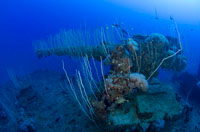
Gun on the USS Carlisle.
Photo: Luke BaadeThe USS Carlisle (APA-69) attack transport shows plenty of atomic bomb damage from the Test Able blast that sunk her. She sits upright on the bottom. All along the port side of the ship the hull has been folded like paper. Folds go horizontally along the entire length of the hull. Extensive damage on the superstructure and the main deck forward has collapsed. The starboard side of the hull is largely intact. There are interesting artefacts on the main deck aft towards the stern.
IJN Sakawa light cruiser
I passed on the opportunity to dive on the Japanese light cruiser IJN Sakawa, preferring to do yet another dive on the USS Saratoga instead.
Scuba Diving at Bikini Atoll
Let's face it, the magnitude of a dive expedition to Bikini Atoll isn't for everyone. First there is the sheer isolation. You're aboard a 24 metre vessel for 14 or so days out at sea, 25 to 30 hours away from the nearest help which is a USA missile testing base, and they don't want to know you. You can either enjoy the wonderful freedom of having no cell-phone or Internet service, or despair at being cut off from the world.
But if you go, you will get to experience what is without a shadow of a doubt the best wreck diving you will do in your diving career. Plus you're in water at a temperature of 30 degrees Centigrade, with 40 to 60 metre visibility. Wow!

Divers on the MV Windward deco bar.
Photo: Lloyd BorrettYou get to do two decompression dives per day, diving to 45 to 55 metre max depths. The two rebreather divers in our expedition party were typically doing run times of 2 to 3 hours. On open circuit we were typically doing 80 to 100 minute run times and 20 to 30 minute bottom times, with a four to six hour surface interval in between dives.
I dived with twin 12 litre steel cylinders filled to 250 bar with air, carrying an 11 litre aluminium cylinder with 200 bar of EAN50, and then using a 7 litre steel cylinder with 200 bar of EAN95 on the deco bar. While I used the EAN95 to accelerate my deco, when my dive computer cleared, just to be conservative, I still stayed in the water for the same time as the others who were not using EAN95. I'd spend my time on the deco bar going over in my mind the fantastic details of whichever warship we'd just explored.

Deco chamber on MV Windward.
Photo: Lloyd BorrettMV Windward is equipped with a 48-inch, twin lock chamber, deck hyperbaric decompression chamber, to provide safety for advanced remote location sport and technical diving. There is Nitrox, O2, Helium and Sorb, plus steel and aluminium twinsets, deco pony cylinders etc.
On two nights the crew and expedition divers left MV Windward and joined the island maintenance crew at the Bikini Sunset Bar for a tropical beach BBQ. It just doesn't get any better than this.
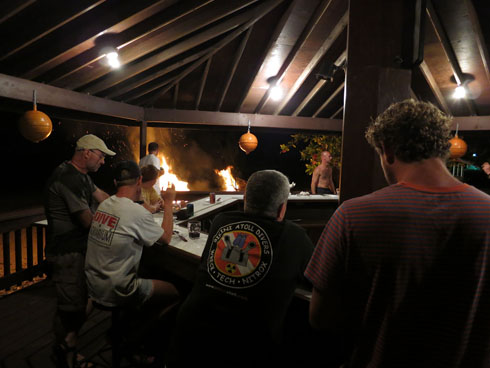
Bikini Sunset Bar. Photo: Lloyd Borrett
After our last dive at Bikini Atoll it was time to wash down kit, and then stow everything securely for the long steam back to Kwajalein Atoll. We arrived back at Ebeye Island in the late afternoon, and then had our last expedition dinner together, celebrating with ice-cream bought on the island.
What about the fish?
After arriving back in Melbourne I was telling a local dive buddy about my amazing experiences at Bikini Atoll. And his first question was, "What about the fish?"
Well the corals of Bikini Atoll have had more than 50 years to recover from the nuclear testing, and the place is again teeming with fish life. With the coral come the reef fish like anemone fish, titan triggers, bat fish and so on. Then there are the fish that feed on the reef fish like snapper, jacks, dogfish tuna, barracuda, grouper and Bluefin trevally. With no-one anywhere near the atoll to harvest them, Bikini Atoll is now a plentiful and pristine fishing environment.
Sharks are a constant factor. Edward Maddison's eyes nearly popped out of his head when a tiger shark came in for a very close look while we were on the deco bar. No-one goes in the water in the morning or the evening because that's when the sharks feed.
I was told one dive group, back in the land-based diving days, wanted to do a night dive so they loaded the boat, got their gear together, motored out to a wreck site and dropped into the blackness. When they shone their lights around, all they could see was a wall of shark eyeballs glowing eerily in the sea around them. The night dive was aborted immediately and never attempted again.
Usually a dive at "Shark Pass" is scheduled, however because we'd missed a day at Bikini Atoll due to the missile testing, many of us were keen to pass on this and do another wreck dive instead. As it turned out, adverse weather conditions meant we couldn't do this dive anyway.
The thing is, at Bikini Atoll you're diving in the greatest warship wreck museum in the world. We were there to see the historic warships and the results of an atomic attack on a naval fleet. Unlike dive destinations like the Galapagos Islands and Great Barrier Reef, we were not there to look at the fish!

Bikini Atoll Dive Expedition October 2012. Photo: Lloyd Borrett
Do YOU want to go?
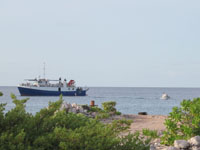
Liveaboard MV Windward off Bikini Island
Photo: Lloyd BorrettWith only 12 divers able to be accommodated on MV Windward, and only a handful of expeditions each year, Bikini Atoll is now a very exclusive dive destination. Less than 100 divers per year get the opportunity to dive the nuclear fleet at Bikini Atoll. Yet the cost has come down to around A$7,900 plus expenses, per diver, ex Cairns. Go figure! I personally rate this a much better value for money than dive trips I've done to the Galapagos Islands and to dive the HMS Hermes aircraft carrier off the east coast of Sri Lanka.
The Scuba Doctor has one dive expedition to Bikini Atoll scheduled for October 2013 and there are just three spots left. The two expeditions Peter Fear has organised for October 2014, already have just eight spots left in total. See http://bit.ly/QRRjFt for the details. This highlights the demand from those who realise Bikini Atoll is a world heritage site and a bucket-list destination for serious wreck divers.
I suggest you book to go ASAP. Who knows if the liveaboard will remain a viable operation with so many rising costs? Besides, the wrecks will not last forever. Peter Fear and Edward Maddison kept describing just how they were changing on each visit.
From my experience at Bikini Atoll in October 2012, all of the hoopla ever spoken about the sunken nuclear ghost fleet is all true. Except, that I didn't come back glowing in the dark! I will be back!
Video "Bikini Atoll 2012 - the Nuclear Fleet" from The Scuba Doctor's October 2012 dive expedition.
Credit: Manu Raze. (25:00)
About the author:
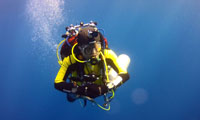
Lloyd Borrett doing deco at Bikini Atoll.
Photo: Bill JakobLloyd Borrett is a Melbourne, Australia based technical and recreational diver (www.borrett.id.au). Lloyd enjoys diving the wrecks, walls and temperate water reefs in southern Australia, and also journeying far and wide on dive trips and expeditions to seek out interesting dive sites. He has recently returned from wreck diving at the "bucket list" destination of Bikini Atoll, and is already planning to go back there again in October 2013.
Book your ultimate dive expedition to Bikini Atoll
The Scuba Doctor has Bikini Atoll dive expeditions arranged for October 2013 and 2014. The dive trips are ex Cairns and are a 14-day turn around allowing for 1-day steaming from Kwajalein Atoll to Bikini Atoll and 1-day return, plus 10-days of diving for 20 dives.
For information on these trips, or if you would like to plan other dates, please contact [email protected] or phone 03 5985 1700. Trips are limited to 10 divers.
Warning: Scuba diving at Bikini Atoll will change you forever. Some divers on earlier expeditions with The Scuba Doctor to Bikini Atoll in earlier years simply stopped diving for a year or more after the trip. Nothing else could measure up after Bikini Atoll. Don't miss out. Book your spot today!



